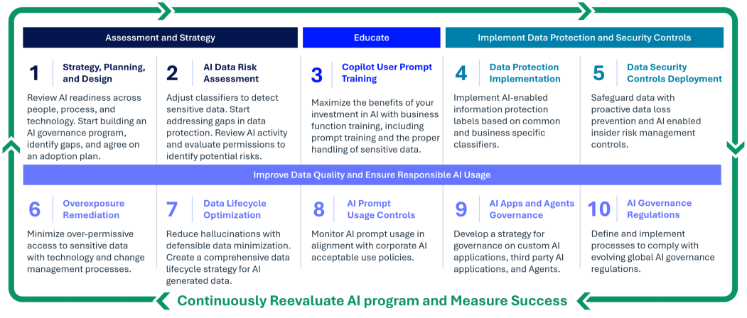


Preparing Your Organization for Copilot: Strategy, Planning, and Design
- eDiscovery
- 3 mins
As organizations journey into automated productivity, the first step is not about deploying AI tools; it’s about laying the groundwork for adoption. Before diving into products like Microsoft Copilot, creating a strategy based on your organization’s goals, readiness, and existing capabilities is critical. This essential planning phase facilitates a secure and scalable AI adoption aligned with your unique business goals.

What Is Copilot Readiness and Why Does It Matter?
Copilot readiness means your organization is equipped to responsibly implement and leverage AI tools with security and efficiency. Teams need a framework that supports safe experimentation and growth. This includes training users to integrate AI into their daily workflows, ensuring data is protected and well-governed, and gaining visibility into both sanctioned and unsanctioned AI use.
Finding Gaps Across People, Process, and Technology
The first action in this phase is a gap analysis across three domains: people, process, and technology.
People: Evaluate how well your staff and leadership are prepared for AI adoption. This includes identifying key stakeholders across departments, engaging internal champions with existing Copilot or AI experience, and establishing a Center of Excellence to promote best practices and training. Regular staff training on privacy best practices and continuous assessment support adaptation to new threats or regulatory changes. The absence of practical training and real-world application strategies undermines confidence, increases resistance to change, and limits the value AI can deliver.
Involve the right people early. Without representation from all relevant departments, your AI strategy may lack the depth and support it needs. When the right people are involved from the start, teams gain alignment, defensibility, and the operational clarity needed to turn AI strategy into measurable results.
Process: Assess whether your organization has a formal data protection or privacy program in place that is routinely reviewed and strengthened. Such a program establishes clear policies and procedures for handling sensitive information, ensuring compliance with relevant data protection regulations (e.g., GDPR, PCI DSS, or HIPAA), and defining roles and responsibilities for data stewardship. The program will include processes for identifying sensitive data, controlling access, monitoring data flows, and responding to potential incidents or breaches. By having a reliable framework, you ensure that AI adoption is both secure and aligned with your organization's core values and compliance requirements.
Evaluate whether your organization has standardized processes for labeling and classifying both structured and unstructured data. For structured data, automated rules and metadata tags flag sensitive content like personal or financial information. Unstructured data (e.g., emails or documents) requires tools such as natural language processing or manual review for accurate labelling. Integrating classification across data management systems enables dynamic access controls and supports risk management and regulatory needs. These policies provide a foundation for advanced controls such as encryption and Data Loss Prevention (DLP), ensuring sensitive assets are protected throughout their lifecycle.
Consider how users are trained to handle sensitive information. This is the time to begin drafting acceptable use policies and AI governance frameworks. Establishing governance structures early on that address model transparency, explainability, and risk mitigation strategies is crucial to combat issues like hallucinations, data leakage, and model drift. This early integration enables teams to gain control, confidence, and a defensible foundation for scaling AI responsibly.
Technology: Review your current tech stack to identify gaps. Begin by conducting a thorough audit of your current data security posture, including the effectiveness of existing data protection measures and insider risk protocols. Assess whether you have controls in place for managing access, monitoring activity, and responding to potential insider threats or external breaches.
Identify any vulnerabilities, perhaps outdated policies, insufficient access restrictions, or gaps in monitoring sensitive data movement. This involves reviewing how data is stored, shared, and classified across platforms and ensures that only authorized personnel have access to confidential information.
Your people, process, and technology gap analysis will help you prioritize remediation efforts, focusing first on the most critical assets and processes. Ultimately, these actions ensure that when AI is introduced, it interacts only with data that has been properly safeguarded and authorized, giving your team the confidence to move faster, reduce risk, and unlock the real value of AI.
Building a Customized AI Adoption Plan
Organizations should tailor their AI adoption strategies to both operational realities and long-term strategic objectives. Begin by leveraging tools such as Microsoft SharePoint Advanced Management (SAM) and Data Security Posture Management (DSPM) for AI. These solutions enable proactive data exposure auditing and access control tightening to ensure that sensitive business information remains accessible only to appropriate personnel.
In cases where there is a need to restrict AI access to critical or confidential information, deploy targeted DLP policies to prevent AI from processing files labeled with high-risk or sensitive classifications.
To further enhance data quality and operational efficiency, implement Data Lifecycle Management (DLM) practices to categorize content as Relevant, Obsolete, or Trivial (ROT). This streamlines data repositories, improves the quality of inputs grounding your AI, and supports informed decision-making. Coupling DLM with Records Management (RM) guarantees regulatory compliance, prevents unauthorized changes, and protects crucial business information from accidental loss.
Supporting these controls, organizations should establish continuous monitoring systems and automated alerts to quickly detect and respond to unusual activity or potential threats. These steps create a resilient framework that positions organizations to confidently lead and innovate as legal technology evolves.
Top Factors That Influence Your AI Strategy
Several factors influence how ready your business is to embrace this change, and understanding these elements is key to unlocking the full potential of AI.
Data quality issues, such as inaccurate, incomplete, duplicated, or poorly labeled information, undermine the effectiveness of AI. Such problems result in unreliable analytics and misguided decisions. To remediate this, conduct regular data audits to identify and correct errors, standardize data formats, ensure proper tagging and classification, and remove obsolete or redundant records.
Neglecting training on prompts, agents, and the development of concrete use cases also creates obstacles. Teams lacking prompt engineering skills and a clear understanding of agent capabilities often misuse or underutilize AI, leading to poor adoption rates and disappointing outcomes. Without practical use cases, AI initiatives remain abstract and disconnected from daily work, causing confusion and skepticism among staff.
By anchoring your AI initiatives in clear goals and governance, you ensure that every deployment is purposeful, secure, and aligned with what matters most to your organization. This approach accelerates time-to-value by directing efforts toward use cases that drive meaningful results, while simultaneously safeguarding against costly missteps and regulatory pitfalls. Proactively addressing legal, ethical, and security requirements builds organizational trust and encourages responsible innovation with AI. In short, when strategy and compliance are woven into the fabric of your AI adoption plan, you lay the groundwork for scalable growth, lasting transformation, and resilient leadership in a shifting digital landscape.
When strategy is grounded in these core drivers, organizations not only maximize the benefits of their investments but also build a resilient foundation that mitigates risk and fosters trust. The organizations that prepare today by thoughtfully aligning technology with purpose and compliance will lead tomorrow.

Paul Renehan, Senior Director, Advisory and Implementation, Epiq
Paul Renehan is a seasoned leader with over two decades of experience in data governance, information protection, and eDiscovery. Throughout his career, he has successfully led strategic initiatives that enhanced data quality, security, and regulatory compliance across diverse industries and sectors. Paul has partnered with numerous Fortune 100 companies to design and implement best practices, frameworks, and policies that align data governance and protection with business goals and regulatory standards.
Paul brings deep expertise in data analysis, architecture, quality, privacy, and security, and is proficient in a wide range of tools and technologies supporting these domains. He is well-versed in global standards and regulations, including GDPR, CCPA, HIPAA, PCI-DSS, ISO 27001, and NIST.
Paul holds a BS in Information Systems from Northeastern University’s D'Amore-McKim School of Business. He is a Microsoft Certified Information Protection Administrator, Microsoft Certified Security Administrator, and a Certified eDiscovery Specialist (CEDS). He frequently speaks at industry conferences and events and annually addresses graduate students on international business and legal technology trends.
In his current role at Epiq, Paul leads a team of experts delivering strategic data governance and information protection solutions to clients, ensuring data integrity and compliance throughout the lifecycle. He also collaborates closely with Epiq Risk and Compliance leadership to align internal governance initiatives with enterprise objectives.

Jeremy Sawyer, Director, Solutions Architecture, Epiq
As the Director of Solutions Architecture at Epiq, Jeremy utilizes Microsoft Purview to address client business requirements by aligning organizational goals with Microsoft technologies, with a strong emphasis on data protection and security. As a Copilot Power user and Agentic AI enthusiast, he recognizes the significance of deploying AI responsibly, ensuring sensitive data is protected and insider threats are minimized. Jeremy develops customized project scopes and proposals aimed at bolstering data security and preventing leaks. He provides organizations with strategic guidance for implementing Copilot safely, focusing on AI readiness through a balanced approach to people, process, and technology.
Previously, as a Cloud Architect at Varonis, Jeremy specialized in M365 across North America, collaborating with product management, sales leadership, engineering, development, and marketing, while supporting multiple sales teams throughout the United States on data protection solutions. His earlier positions include Senior Solutions Architect, Director, and Technical Lead for Infrastructure and Azure Services at SADA Systems. With over two decades of experience, Jeremy excels in planning, designing, implementing, and securing both on-premises and cloud infrastructure.
The contents of this article are intended to convey general information only and not to provide legal advice or opinions.